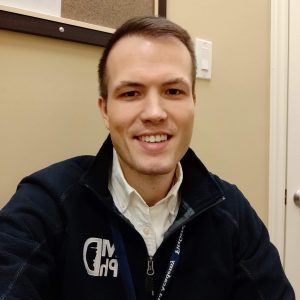
Patrick Steadman – Hospital for Sick Children University of Toronto
Scientific publication:
Steadman, P. E., Xia, F., Ahmed, M., Steenland, H. W., Mocle, A. J., Penning, A., Geraghty, A. C., Monje, M., Josselyn, S. A., Frankland, P. W. (2019) Disruption of oligodendrogenesis impairs memory consolidation in adult mice. Neuron 105, 1–15, doi:10.1016/j.neuron.2019.10.013
https://www.cell.com/neuron/pdf/S0896-6273(19)30886-4.pdf
Laboratory website:
Dr. Patrick Steadman lives in Toronto, Ontario.
Memory consolidation depends on myelin formation on neurons
Myelin is a form of electric insulation surrounding neurons, increasing the speed and efficacy of the transmission of electrical impulses in the brain and nerves. Myelin in the brain is formed by specialized cells called oligodendrocytes. These oligodendrocytes are generated throughout life and partially regulated by the activity of neurons.
New research by Patrick Steadman, an MD/PhD student in Paul Frankland’s laboratory at SickKids Hospital in Toronto is now the first to show that memory consolidation involves myelin formation, and this formation facilitates communication between brain regions. These results confirm a leading theory suggesting new myelin in the brain results from memory formation, and this additional myelin facilitates communication and coordination across brain regions necessary for memory function.
The researcher found that mice who learn to navigate a water maze have more myelin-producing oligodendrocytes and increased myelination of brain regions important for learning. Preventing learning-induced new oligodendrocyte formation without affecting existing oligodendrocytes impaired memory consolidation of the water maze, as well as consolidation of contextual fear memories. These results suggest that new myelin formation tunes neuronal circuits, promoting coordinated activity that is important for memory consolidation. Consistent with this, contextual fear learning resulted in an increased the coupling of signals between two brain regions — the hippocampus and the cortex — and these learning-induced increases were blocked when formation of new oligodendrocytes was suppressed.
These results identify a non-neuronal form of modification of brain circuits that can remodel how signals are transmitted between brain regions following learning and that is required for memory consolidation.
Dr. Patrick Steadman
This work was done while Patrick Steadman was an MD/PhD student at the University of Toronto in the laboratory of Dr. Paul Frankland at SickKids hospital. Patrick Steadman previously completed a MSc in medical biophysics. This contribution was the main feature of his PhD where Patrick designed the experiments and either collected the data or coordinated its collection amongst a team of researchers from undergraduates to post-doctoral fellows. The analysis of data was performed by Steadman or under his guidance. Data interpretation was performed by Steadman in collaboration with his PhD supervisor.
Funding:
- This work was supported by Canadian Institutes of Health Research (CIHR) grants FDN143227 and PJT156164 (Dr. Frankland) and MOP74650 (Dr. Josselyn).
- Dr. Josselyn is a CIHR Canada Research Chair in Memory Function and Dysfunction. Dr. Frankland is a CIHR Canada Research Chair in Cognitive Neurobiology.
- Dr. Steadman was supported by a CIHR Vanier graduate scholarship, an Arnie Aberman fellowship, and a McLaughlin MD/PhD studentship.
